spare tire CHEVROLET ASTRO 1997 2.G Owners Manual
[x] Cancel search | Manufacturer: CHEVROLET, Model Year: 1997, Model line: ASTRO, Model: CHEVROLET ASTRO 1997 2.GPages: 404, PDF Size: 20.63 MB
Page 219 of 404

Downloaded from www.Manualslib.com manuals search engine Section 5 Problems on the Road
Here you’ll find what to do about some problems that can occur on the road.
5-2
5-3
5-3
5-7
5- 13
5-15
Hazard Warning Flashers
Other Warning Devices
Jump Starting
Towing Your Vehicle
Engine Overheating Cooling System 5-22
5-22
5-23
5-35
5-36
Engine Fan Noise
If
a Tire Goes Flat
Changing a Flat Tire
Compact Spare Tire
If You’re Stuck: In Sand, Mud, Ice or Snow
Page 242 of 404
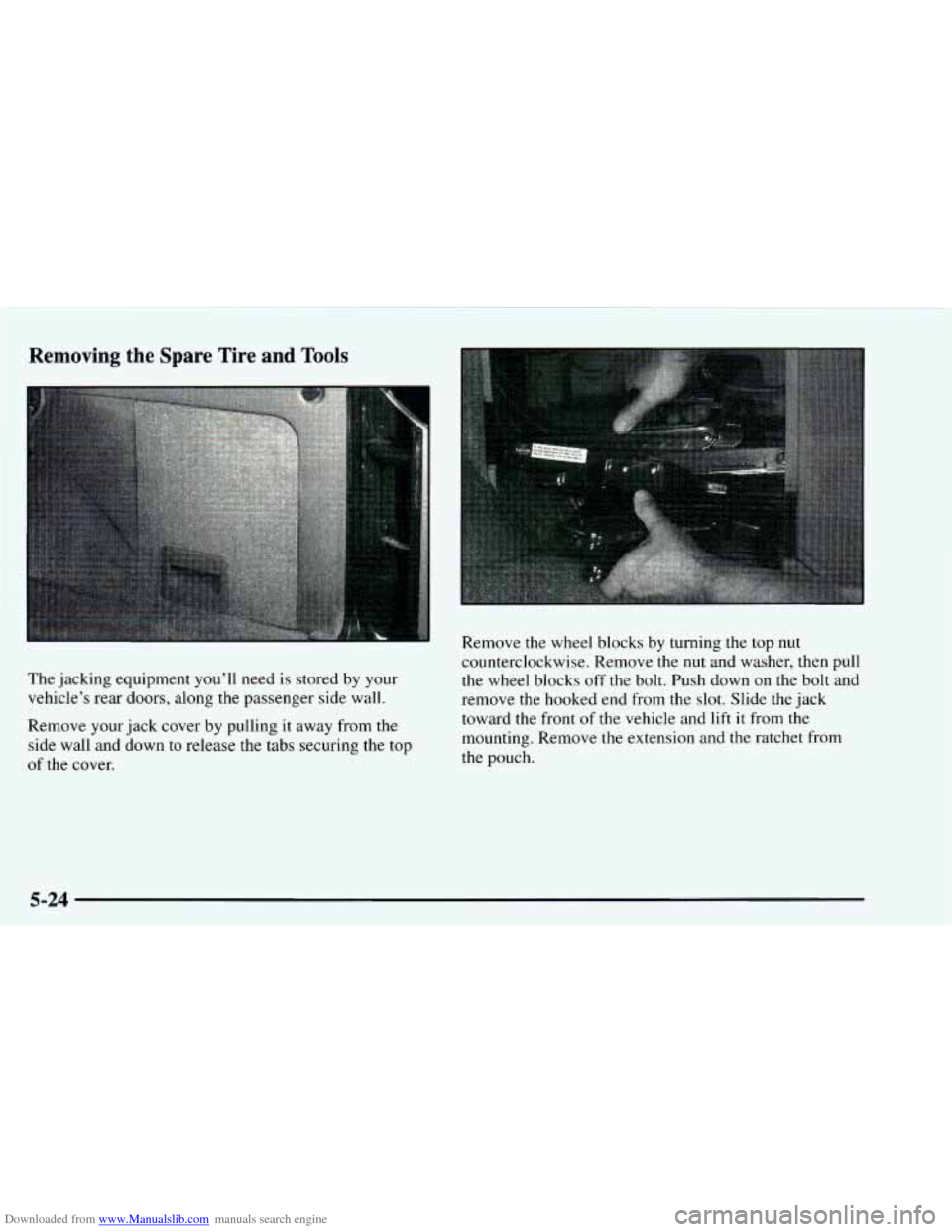
Downloaded from www.Manualslib.com manuals search engine Removing the Spare Tire and Tools
The jacking equipment you’ll need is stored by your
vehicle’s rear doors, along the passenger side wall.
Remove your jack cover by pulling it away from the
side wall and down
to release the tabs securing the top
of the cover. Remove the wheel blocks
by turning the top nut
counterclockwise. Remove the nut and washer, then pull
the wheel blocks off the bolt. Push down on the bolt and
remove
the hooked end from the slot. Slide the jack
toward the front
of the vehicle and lift it from the
mounting. Remove the extension and
the ratchet from
the pouch.
5-24
Page 243 of 404
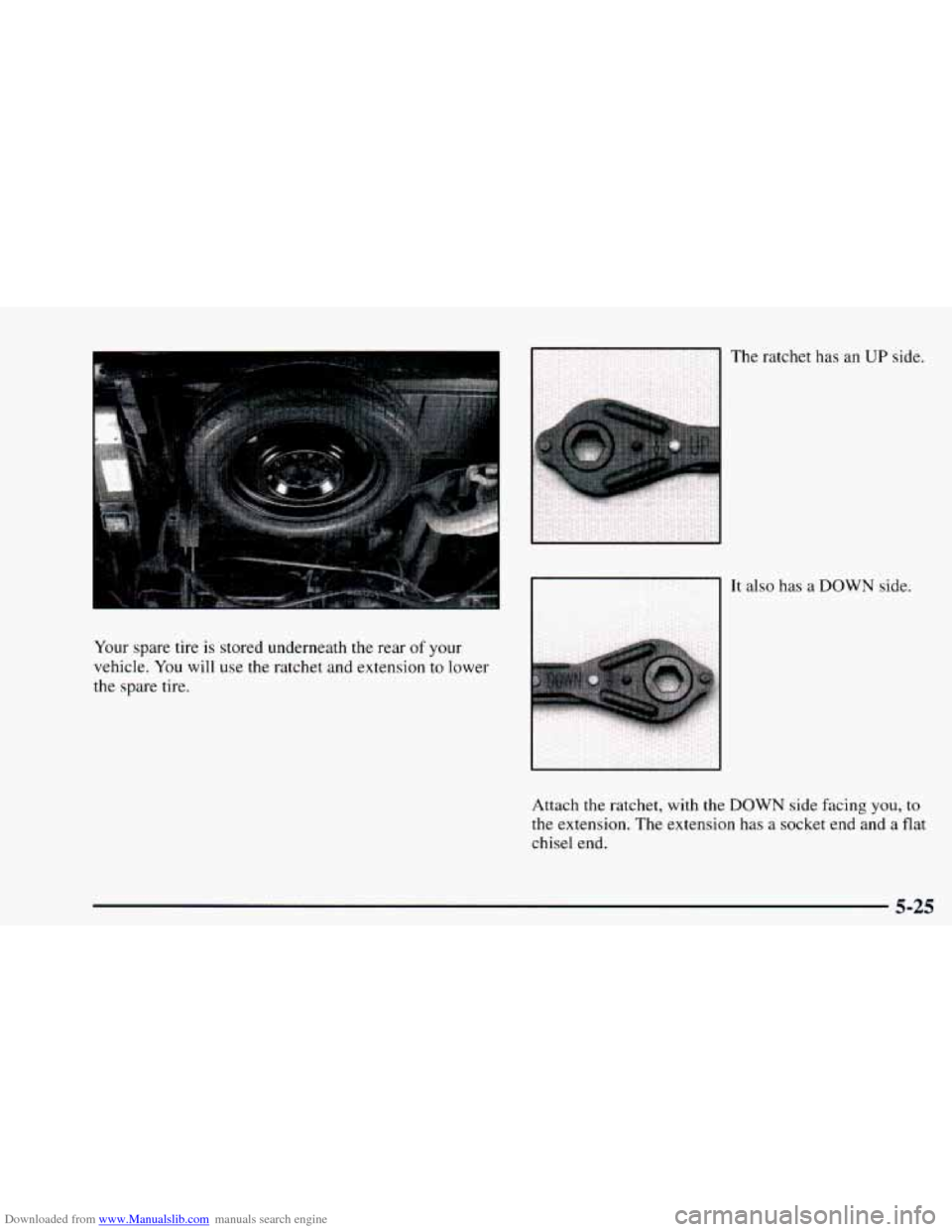
Downloaded from www.Manualslib.com manuals search engine Your spare tire is stored underneath the rear of your
vehicle. You will use the ratchet and extension to lower
the spare tire. It
also has a DOWN side.
Attach the ratchet, with the
DOWN side facing you, to
the extension. The extension has
a socket end and a flat
chisel end.
5-25
Page 244 of 404

Downloaded from www.Manualslib.com manuals search engine Put the flat end of the extension on an angle through the
hole in the rear door frame, above the bumper. Be sure
the flat end connects into the hoist shaft.
Turn the ratchet counterclockwise to lower the spare tire
to the ground. Keep turning the ratchet
until the spare
tire can
be pulled out from under the vehicle. When the
tire has been
lowered,
tilt the retainer at
the end
of the cable and pull
it through the wheel opening.
Pull the tire out from under the vehicle.
I NOTICE:
To help avoid vehicle damage, do not drive the
vehicle before cable is restored.
5-26
Page 248 of 404
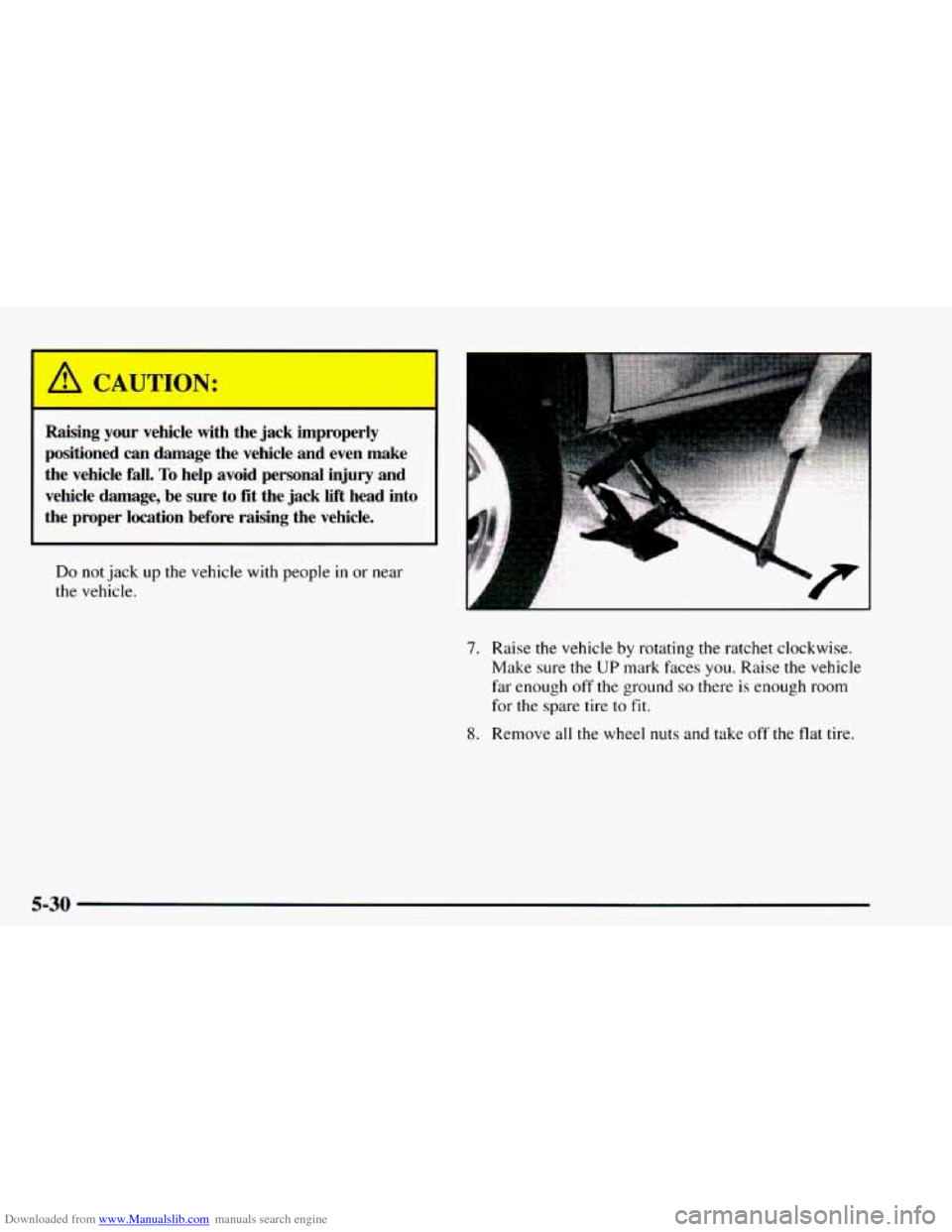
Downloaded from www.Manualslib.com manuals search engine Raising your vehicle with the jack improperly
positioned can damage the vehicle and even make
the vehicle fall.
To help avoid personal injury and
vehicle damage, be
sure to fit the jack lift head into
the proper location before raising the vehicle.
~ ~ ~ ~~~~~~~~ ~~ ~ ~ ~
Do not jack up the vehicle with people in or near
the vehicle.
7. Raise the vehicle by rotating the ratchet clockwise.
Make sure the
UP mark faces you. Raise the vehicle
far enough off the ground
so there is enough room
for the spare tire
to fit.
8. Remove all the wheel nuts and take off the flat tire.
5-30
Page 249 of 404
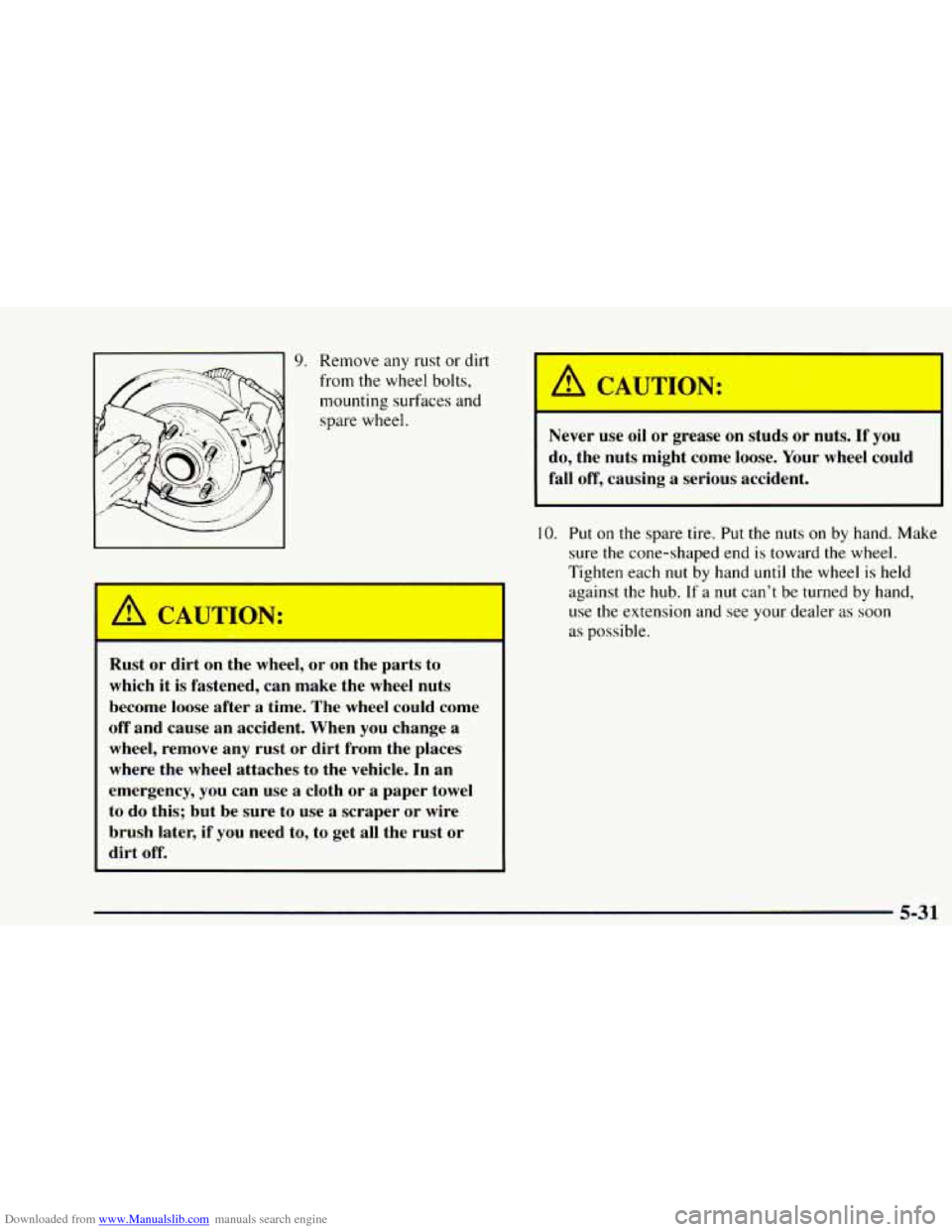
Downloaded from www.Manualslib.com manuals search engine I A CAUTION:
9. Remove any rust or dirt
from the wheel bolts, mounting surfaces and
spare wheel.
Rust or dirt on the wheel, or on the parts to
which it is fastened, can make the wheel nuts
become loose after a time. The wheel could come
off and cause an accident. When you change a
wheel, remove any rust or dirt from the places
where the wheel attaches to the vehicle. In an
emergency, you can use
a cloth or a paper towel
to do this; but be sure to use a scraper or wire
brush later, if you need to, to get all the rust or
dirt off.
A CAI'TION:
Never use oil or grease on studs or nuts. If you
do, the nuts might come loose. Your wheel could
fall
off, causing a serious accident.
10. Put on the spare tire. Put the nuts on by hand. Make
sure the cone-shaped end
is toward the wheel.
Tighten each
nut by hand until the wheel is held
against the hub.
If a nut can't be turned by hand,
use
the extension and see your dealer as soon
as possible.
5-3 1
Page 251 of 404

Downloaded from www.Manualslib.com manuals search engine NOTICE:
Improperly tightened wheel nuts can lead to
brake pulsation and rotor damage.
To avoid
expensive brake repairs, evenly tighten the wheel
nuts in the proper sequence and to the proper
torque specification.
13. Remove the wheel blocks.
I NOTICE:
Wheel covers won’t fit on your compact spare. If
you try to put a wheel cover on your compact
spare, you could damage the cover or
the spare.
Storing a Flat or Spare Tire and Tools
Storing a jack, a tire or other equipment in the
passenger compartment
of the vehicle could
cause injury. In a sudden stop
or collision, loose
equipment could strike someone. Store all these
in the proper place.
1. Put the flat tire on the ground at the rear of the
vehicle, with the valve stem pointed down.
2. Tilt the retaining bar downward and through the
wheel opening. Make sure
it is fully seated across the
underside
of the wheel. Attach the ratchet, with the
UP side facing you, to the extension.
5-33
Page 252 of 404
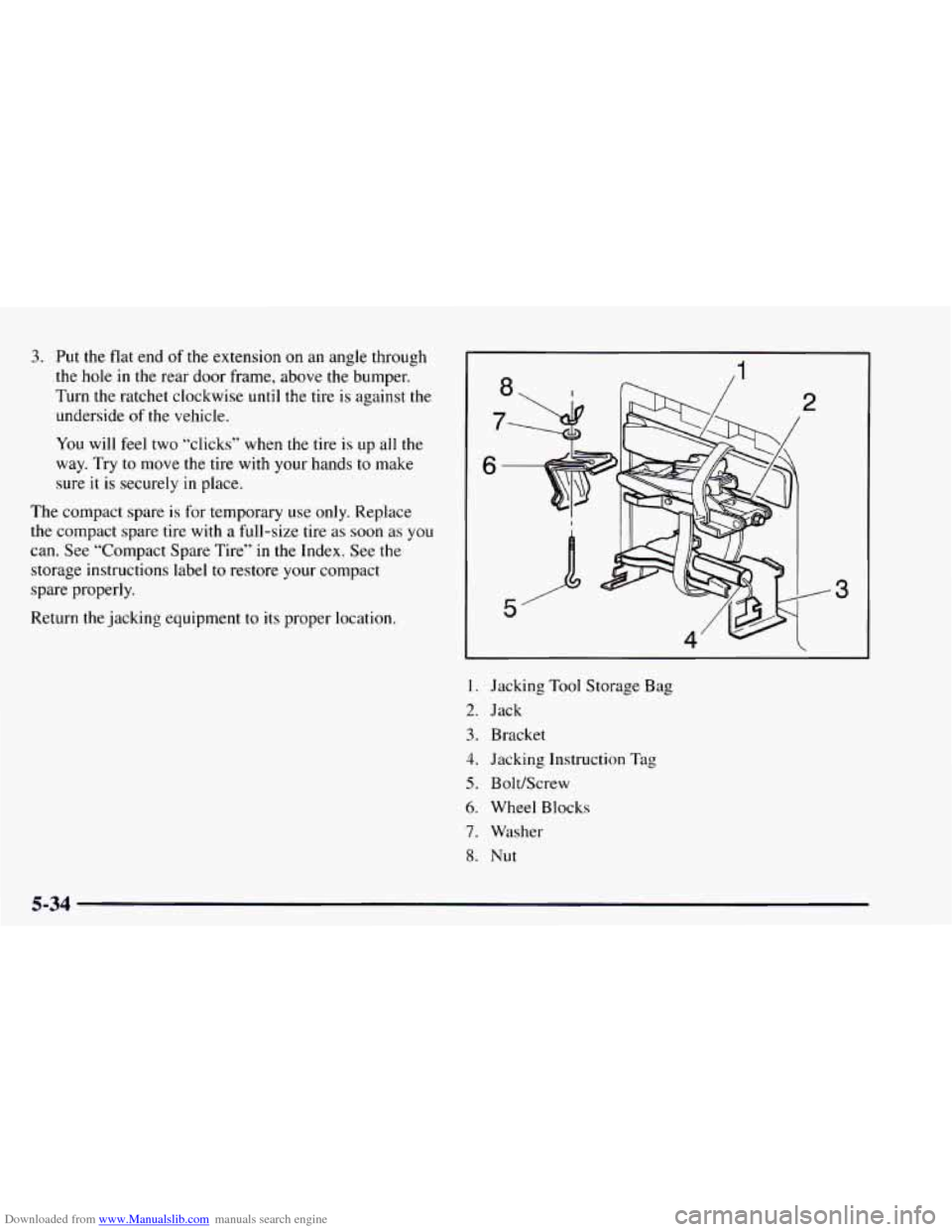
Downloaded from www.Manualslib.com manuals search engine 3. Put the flat end of the extension on an angle through
the hole in the rear door frame, above the bumper.
Turn the ratchet clockwise until the tire is against the
underside
of the vehicle.
You will feel two “clicks” when the tire is up all the
way. Try
to move the tire with your hands to make
sure it is securely in place.
The compact spare is for temporary use
only. Replace
the compact spare tire with a full-size tire as soon as you
can. See “Compact Spare Tire”
in the Index. See the
storage instructions label to restore your compact
spare properly.
Return the jacking equipment
to its proper location.
I
3
. Jacking Tool Storage Bag
2. Jack
3. Bracket
4. Jacking Instruction Tag
5. Bolt/Screw
6. Wheel Blocks
7. Washer
8. Nut
5-34
Page 253 of 404
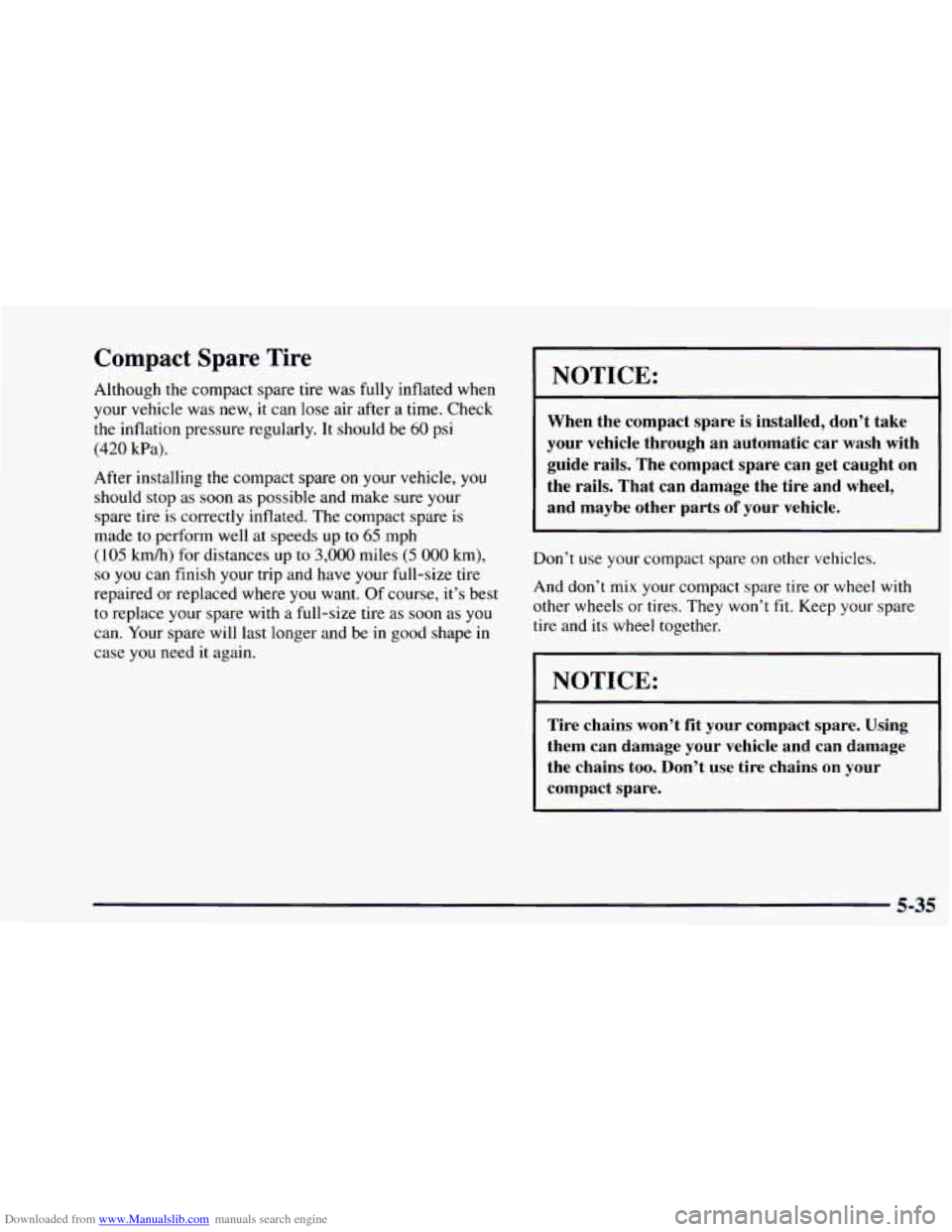
Downloaded from www.Manualslib.com manuals search engine Compact Spare Tire
Although the compact spare tire was fully inflated when
your vehicle was new, it can lose air after a time. Check
the inflation pressure regularly. It should be
60 psi
(420 kPa).
After installing the compact spare
on your vehicle, you
should stop as soon as possible and make sure your
spare tire is correctly inflated. The compact spare is
made
to perform well at speeds up to 65 mph
(105 kdh) for distances up to 3,000 miles (5 000 km),
so you can finish your trip and have your full-size tire
repaired
or replaced where you want. Of course, it’s best
to replace your spare with a full-size tire as soon as
you
can. Your spare will last longer and be in good shape in
case
you need it again.
NOTICE:
When the compact spare is installed, don’t take
your vehicle through an automatic car wash with
guide rails. The compact spare can get caught on
the rails. That can damage the tire and wheel,
and maybe other parts
of your vehicle.
Don’t use your compact spare on other vehicles.
And don’t mix your compact spare tire or wheel with
other wheels or tires. They won’t
fit. Keep your spare
tire and its wheel together.
NOTICE:
Tire chains won’t fit your compact spare. Using
them can damage your vehicle and can damage
the chains too. Don’t use tire chains on your
compact spare.
5-35
Page 300 of 404

Downloaded from www.Manualslib.com manuals search engine Inflation -- Tire Pressure
The CertificationRire label, which is on the rear edge of
the driver’s door, shows the correct inflation pressures
for your
tires when they’re cold. “Cold” means your
vehicle has been sitting for at least three hours or driven
no more than
1 mile (1.6 km).
NOTICE:
Don’t let anyone tell you that underinflation or
overinflation is all right.
It’s not. If your tires
don’t have enough
air (underinflation), you can
get the following:
Too much flexing
Too much heat
0 Tire overloading
Bad wear
Bad handling
Bad fuel economy.
NOTICE: (Continued) NOTICE: (Continued)
If your tires have too much air
(overinflation),
you can get the following:
0 Unusual wear
0 Bad handling
Rough ride
0 Needless damage from road hazards.
When
to Check
Check your tires once a month or more.
Don’t forget your compact spare tire.
It should be at
60 psi (420 kPa).
How to Check
use a
good quality pocket-type gage to check tire
pressure.
You can’t tell if your tires are properly inflated
simply by looking at them. Radial tires may look
properly inflated even when they’re underinflated.
Be sure to put the valve caps back
on the valve stems.
They help prevent leaks by keeping
out dirt and moisture.
6-44